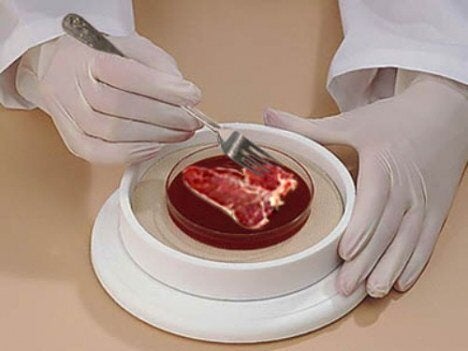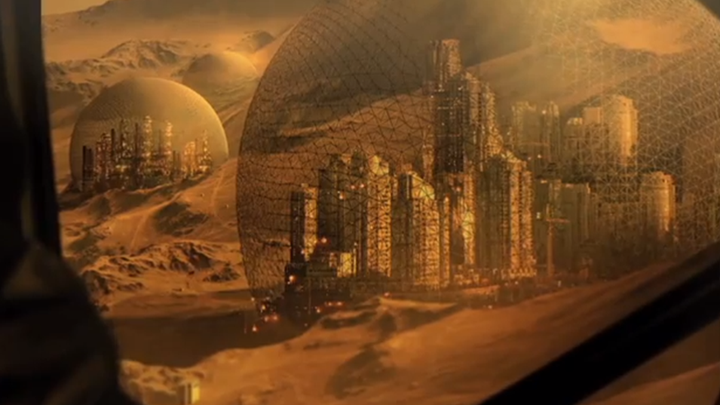"We shall escape the absurdity of growing a whole chicken in order to eat the breast or wing, by growing these parts separately under a suitable medium", these are the words that Winston Churchill used to express his faith in the wonders of tissue engineering back in 1931. Although he predicted that it could be achieved in 50 years, his concept is not far from reality today.
Starvation, muscle-related diseases, destruction of the global natural ecosystems, animal suffering and space colonization are only a few of the reasons that make musculoskeletal tissue engineering a worthwhile science to pursue. That's what I said to myself a few years back when I started developing artificial muscle in the lab, facing these challenges with innovative vision, will and determination to succeed. After all, willpower is a muscle; the more you use it the stronger it gets.

Creating meat without the expense of the animal is within humankind's reach.
One of the most expensive dishes in history, a lab-grown 140 gram burger, costing approximately £215,000 was cooked and tasted on-air in a TV studio in Hammersmith about two weeks ago. An intensely stressful event for the chef (cooking a one-of-it's-kind £215,000 burger in front of more than 100 journalists is a touch more intense than a chef's average day), a "gross" moment for others and a thrilling technological outcome for scientists all over the world. For those of you who tend to have a yucky reaction or think of it as a highly controversial topic, maybe considering the infectious outbreaks that are exemplified through animal breeding like SARS, H1N1 Swine Flu pandemic, and Mad Cow/prion disease or even the tail docking, castration, debeaking ,even tooth cutting that take place without anesthetic in animal facilities, will help you rationalize the incentives of the unconventional science of muscle engineering. In addition, laboratory grown meat is an essential research avenue in order to deal with the problem of intense land usage and greenhouse gas emission. At the moment, 70% of all agricultural land, corresponding to 30% of the total global surface is being used for livestock production, while 18% of the global greenhouse emission is produced by livestock, which is more than the total emission of the transportation sector. Novel ways to balance this environmental burden could be used by in vitro production processes that can recycle oxygen by way of concomitant photosynthesis, thus reducing CO2 emission. In vitro meat can revolutionize the food industry providing healthy and literally out-of-the-box solutions to environmental and sociological problems and even disturb our mainstream lifestyle. Is there a chance that the people, who have become vegetarian because they are against cruelty to animals, will be willing to eat meat created in vitro? With all the cultural respect, could religious groups like Hindu, Buddist, Muslims, Jain who don't normally eat meat like beef according to their traditions reconsider? Would some authority like the WHO (World Health Organization) stand up against the meat lobby and their giant multibillion dollar industry?
Although developing in vitro meat is associated with many opposing and vested industrial interests seeking to maintain the status quo, the fundamental science behind it is human centric. The discipline of musculoskeletal tissue engineering focuses on the development of artificial muscle with properties that can mimic the pathophysiology and functionality of its real counterpart. Combatting skeletal muscle loss from injuries, aggressive tumors or even prolonged space travel, through the reconstruction of artificial muscle with stem cells and biomaterials is a novel approach that can overcome the limitations of autologous grafting (relocation of muscle tissue from autologous sites to the sites of defect). Primary concerns include the restrains of transplantable muscle mass and the reduced force of the grafted muscle (transplanted muscle can only exert up to 40% of its' original force). Introduction of artificial muscle into clinical settings is undoubtedly challenging, but potentially negative connotations may be off-set by the impact of such a product not only to patients in need of muscle transplants but also to the millions of patients who suffer from musculoskeletal diseases and muscular dystrophies with manifestations in body systems including the heart, gastrointestinal systems, endocrine glands, skin, eyes and other organs. Tissue engineered muscle systems can provide the platforms to study the developmental stages of these diseases and perform drug screening to resolve them. Beside the relatively rare musculoskeletal disorders, engineered skeletal muscle also enables the analysis of more frequent diseases like type 2 diabetes without the use of time-consuming and costly in vivo models. Therefore, it is of paramount importance to introduce a legislative framework and address the bioethical concerns so that a direct bench-to-bedside approach can soon become a reality.
In vitro meat has presented a paradigm shift in the way we can attain meat and has provided true hope for the development of sustainable space colonization. It is now feasible to produce more than 20,000 tons of cultured meat with a single sample of cultured stem cells that would otherwise require more than 400,000 cattle to be slaughtered. Martian domes that can shield radiation and provide suitable atmospheric conditions will act as the first life bioreactors where in vitro meat will be cooked and consumed by their population.

Graphic representation of Martian domes for future human habitation.
I can't think of any essential aesthetic reason that artificial meat needs to simulate the organic, since although myoglobin that is responsible for the red color of meat can be also expressed by cells in culture, in vitro meat can be made in any color and shape. The idea that people on earth and in space would eat meat originating from the lab is not far-fetched. At this very moment, in vitro meat does not completely approximate the authentic in color, taste and structure. However, it seems to me that although it doesn't and won't taste exactly like meat to humans on earth who know the taste of meat, it will taste like meat to the first humans in space, less than 100 years down the line, who never knew any different.